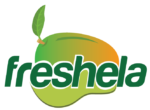
Before the coming of machines, cashew nuts went through a laborious process to get them from the farm to the table. When cashew nut ripened, the apples turned red or yellow. Harvesting was done manually by people separating the cashew nut from the bottom of the apple.
The first process is getting the cashew nuts from the trees, which is the more challenging part since cashew nuts fall when there are strong winds. Without winds, people were forced to shake the tree for the cashew apples to fall on the ground.
Separating cashew nuts from the apple was daunting because each carries one nut. After harvesting, cashew nuts were put in the open sun to dry. This helps the nuts to release excess moisture in their shells for better storage and preservation.
Once they dried, the cashews were roasted on big pans on fires to soften the outer shell for shelling.
The kernels would then be rubbed in hands to peel off the thin layer of skin that protected the cashew, and they would then be sorted into different grades based on size and color. The graded kernels would then be packaged for sale or distribution to retailers.
Cashew Price in Oman
In 2022, cashew imports into Oman were worth approximately 8 million US Dollars. This was an increase from the previous year, marking another high-value record.
The sharpest climb was from 2013 to 2014, when the import value rose from about 1 million US Dollars to over 2 million US Dollars.
Here are the total import values of cashews in Oman between 2013 and 2022.

Cashew Nut Price per kg in Oman
The price of one kilogram of raw cashew nuts in Rial Omani costs between OMR 2.31 and OMR 3.12. ( $ 5.9 to $ 8.10 per kilogram) on the retail market. On the wholesale market, cashews cost between $ 4.19 and $ 5.67 per kilogram.
The market’s supply and demand dynamics significantly influence Oman’s cashew prices. Because Oman depends on other countries for cashews, lower cashew supply by the producing countries means the costs will increase.
Cashew supply fluctuations are a result of production levels in the producing countries. Cashew nuts are harvested once a year, and if the harvest is low, the supply in the market is also doomed to be quiet.
Although the market profits when the cashew prices are higher, cashew consumption is also likely to go lower when the prices are high because of affordability.
Cashews Oman
Oman imports different cashew nuts to meet consumers’ diverse needs and preferences in the market.
Cashew kernels account for the most significant volume of cashew imports in Oman; Kernels are ready-to-eat cashews that have been shelled. They are the most preferred in the market because of their easy application in cooking, making snacks, baking, and processing other cashew products.
Cashew processing is costly and requires a strong labor force. Although it’s not imported in large volumes, some customers need whole cashews for different uses; hence, they’re imported in considerable amounts.
Cashew Nuts Oman
The consumption of cashews in the market determines the type of cashews that Oman imports. When consumers purchase more cashew kernels than cashew products, the country has no choice but to heed the consumer’s needs.
Cashew nuts in Oman are easy to access in different forms and tastes. Local markets in Oman always have cashew nuts at affordable prices, and you can never miss cashew nuts in Supermarkets and grocery stores.
You can also buy from online stores with seasonal offers, discount,s and sales, offering much better prices.
If you are looking for fresh or organic cashews from the farm, buying from farmers gets you quality cashew nuts in a reasonable quantity and at an affordable price.

